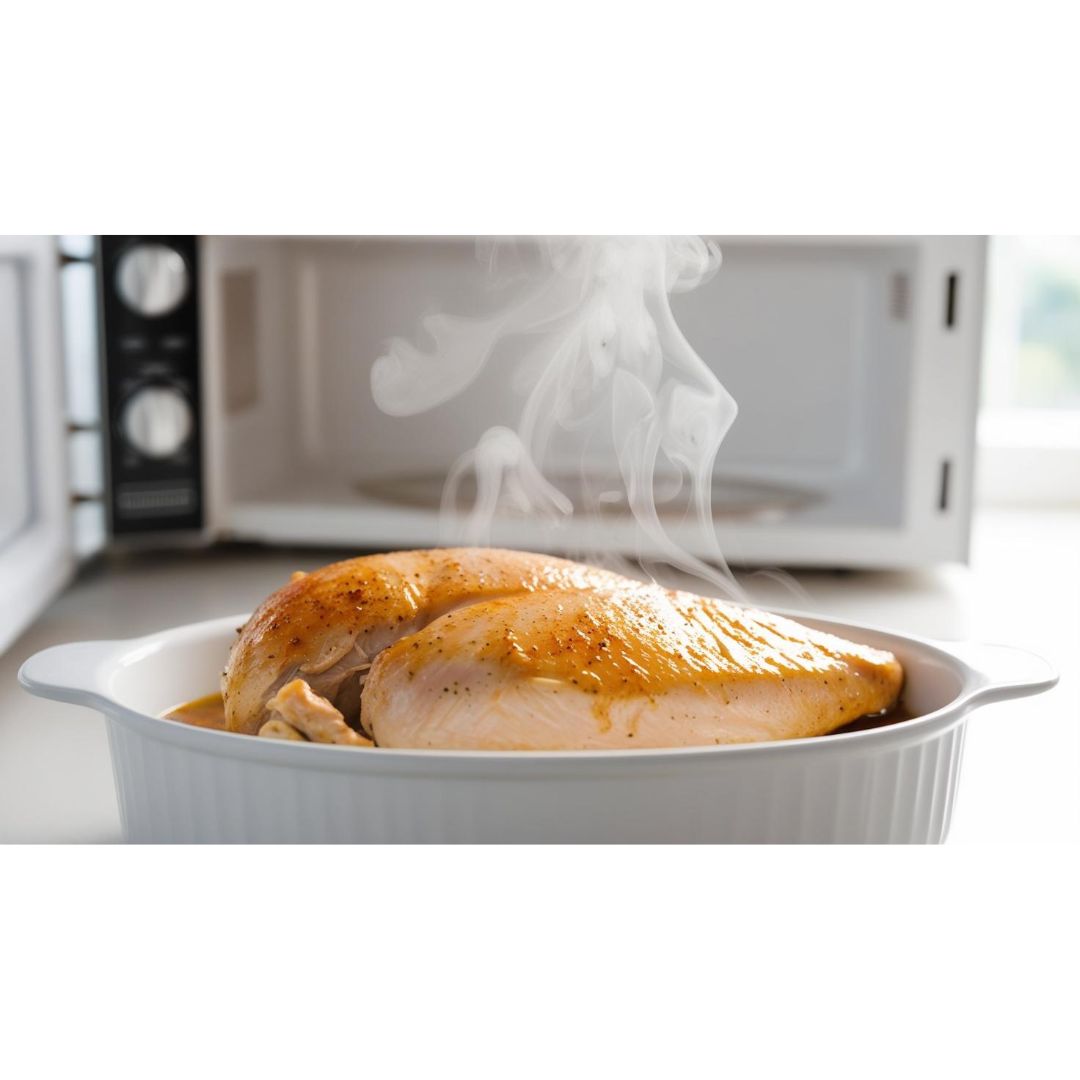What is Warmed Over Flavor?

Have you ever found yourself on a quest to eat healthier, save money, and get back some precious time during your busy week? I think most of us can relate to this idea. For us, it was the catalyst that led us to start meal prepping.
So, we go to the grocery store over the weekend, spend a ton of money on food, spend a full day cooking, do a bunch of dishes—only to get to the office on Monday, throw the tupperware container into the microwave, and alas, the chicken dish we prepped yesterday tastes funky. It’s only a day old, but it tastes off. The next day, the flavor is even worse.
If you’ve had this experience yourself, you’ve encountered what is called warmed over flavor (WOF).
Understanding Warmed Over Flavor
Warmed over flavor is a term often used in discussions about food safety and quality. It refers to the undesirable taste that develops in previously cooked and reheated meats, particularly during storage. This flavor is often characterized by an off, metallic taste that arises from changes in the meat’s fats and proteins. When we reheat food, especially leftovers, certain chemical reactions occur, leading to unpleasant flavors that detract from the overall dining experience.
While it primarily affects meats, WOF can also impact cooked plant-based foods, making them taste stale or flat over time. Understanding why it happens allows us to take steps to prevent it—so we can enjoy our meals without compromising flavor or quality.
What Causes Warmed Over Flavor?
At its core, warmed over flavor is the result of oxidative degradation in food, particularly in proteins and fats. When meat is cooked and then stored, the fats and proteins break down due to exposure to oxygen. This leads to the formation of volatile compounds that alter taste and aroma.
Several types of chemical compounds contribute to Warmed Over Flavor:
- Hexanal and nonanal – These aldehydes develop in reheated foods, particularly in meats, giving them a stale or cardboard-like taste.
- 2-alkenal compounds – These compounds contribute to the off-flavors and altered aromas commonly found in leftovers.
- Lipid oxidation – When fats break down, they produce free radicals that promote further oxidation, leading to unpleasant, rancid flavors.
These compounds are why a meal that tasted great when freshly made can turn into something unappetizing just a day or two later.
Impact on Food Quality and Taste
Warmed over flavor doesn’t just affect how food tastes—it impacts the overall eating experience:
- Flavor Deterioration – Meals shift toward unpleasant, stale, or rancid notes.
- Aroma Changes – The fresh, savory scents of cooked food fade, making reheated meals smell less appealing.
- Texture and Color Alterations – Oxidation can cause meats to dry out faster and even take on an unappetizing appearance.
In meats, WOF is particularly pronounced, often making proteins taste metallic or "off." Even the best seasonings won’t fully mask it once oxidation has taken hold.
Which Foods Are Most Affected by Warmed Over Flavor?
While WOF is most commonly associated with meats, it can affect a variety of foods:
Meat and Poultry
Leftover meats—especially lean proteins like chicken and turkey—are highly susceptible to warmed over flavor. Several factors influence the severity:
- Cooking Method – Grilling and frying can accelerate oxidation, intensifying WOF.
- Storage Time – The longer meat sits in the fridge, the more oxidation occurs.
- Fat Content – While lean meats oxidize quickly, even fatty cuts can develop off-flavors over time.
Cooked Plant-Based Foods
Although WOF is most noticeable in meats, certain plant-based foods can also suffer from flavor deterioration.
- Grains and Legumes – Cooked rice, quinoa, and lentils can develop stale flavors over time.
- Vegetables – Roasted or steamed vegetables may taste dull or lose their freshness after prolonged storage.
- Moisture Content – Foods with higher moisture levels tend to degrade more quickly.
Plant-based dishes can often be revived with fresh herbs, citrus, or minimal water when reheating to restore some of their original taste.
How to Prevent Warmed Over Flavor in Meal Prep
If warmed over flavor is the reason you’ve sworn off meal prepping, don’t give up just yet. There are plenty of ways to avoid it while still reaping the benefits of pre-planned meals.
Avoid Warmed Over Flavor with Smart Cooking and Storage Techniques
- Batch Prep Ingredients, Not Full Meals – Instead of cooking entire dishes ahead of time, prep components (proteins, carbs, and vegetables) separately and assemble fresh when you’re ready to eat.
- Use the Right Cooking Methods – Grilling and frying can accelerate oxidation, but sous vide, roasting, and slow cooking help reduce it.
- Store Food Properly – Use airtight containers or vacuum-sealed bags to limit oxygen exposure. Glass containers are ideal for preserving flavor.
- Freeze Instead of Refrigerate – If you’re meal prepping for more than three days in advance, freezing portions can help maintain taste and texture.
Use Sauces to Combat Warmed Over Flavor
One of the best ways to reduce WOF in meal prep is cooking and storing food in sauces. Sauces create a barrier that protects proteins from oxidation, while their bold flavors help mask any undesirable taste changes.
- Marinades and Sauces Add Moisture and Acidity – Vinegar, citrus, and fermented ingredients like soy sauce help slow oxidation and keep flavors fresh. A great example of this is our Buffalo Beef Taco Bowl Recipe - if you're looking for a recipe to try.
- Tomato-Based and Spiced Sauces Work Best – Curries, tomato-based dishes, and heavily spiced sauces (such as chili, teriyaki, or coconut-based sauces) tend to hold up well over multiple days.
- Oil-Based Sauces Can Provide a Protective Layer – Olive oil, butter, or cream-based sauces coat proteins, limiting oxygen exposure and preventing flavor degradation.
- Wait to Add Sauces Until Reheating (When Possible) – If the dish allows, store proteins separately and add fresh sauce when reheating for the best flavor.
Flavor-Enhancing Strategies
- Use Antioxidant-Rich Spices – Certain herbs and spices (rosemary, thyme, turmeric) contain antioxidants that slow down oxidation.
- Add Acids to Your Meals – A splash of citrus or vinegar can help counteract off-flavors.
- Choose the Right Fats – Saturated fats (like those in butter or coconut oil) are more stable and resist oxidation better than unsaturated fats.
By incorporating sauces and marinades into meal prep, you can keep reheated meals flavorful, fresh, and free from warmed-over taste while still enjoying the convenience of prepped meals.
Final Thoughts: Rethinking Meal Prep
If you’ve struggled with warmed over flavor, you’re not alone. The good news? You don’t have to choose between fresh-tasting meals and the convenience of meal prepping. By making a few small adjustments—like prepping ingredients instead of full meals, using antioxidant-rich seasonings, and optimizing storage methods—you can enjoy all the benefits of meal prep without the dreaded off-flavors.
Have you found ways to keep your meal prep fresh? Let us know in the comments!
